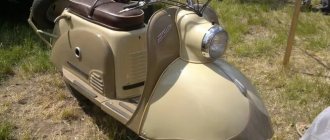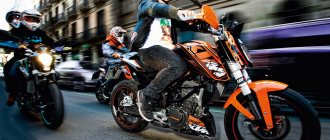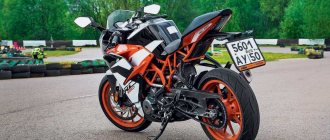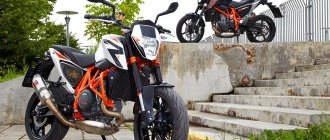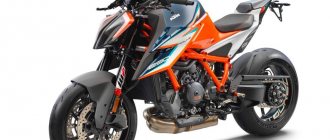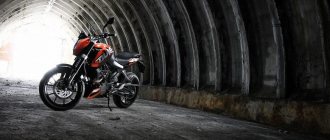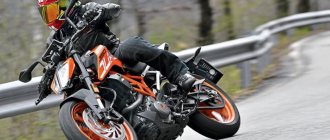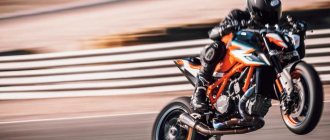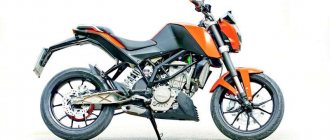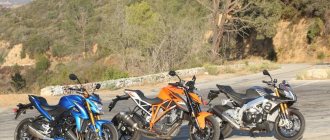At the same time, the KTM Duke 200 is not just another small-capacity craft, of which there are hundreds on the market, but a full-fledged lightweight motorcycle, modern, equipped with everything necessary and generally interesting in all respects. True, it costs much more than some Chinese small-capacity car, but the very first ride on a 200 cc Duke makes it clear that the price is justified. This bike is not just another toy for beginners, designed to teach them how to ride a motorcycle, it is a full-fledged two-wheeled friend, which will likely appeal to experienced bikers as well. Why not? It is ideal for the role of urban transport.
KTM Duke 200 Specifications
If you imagined the perfect lightweight road bike, this is it. In a classic steel frame, Austrian designers (yes, the KTM Duke 200 was developed in Austria after all) placed a single-cylinder 4-valve liquid-cooled engine , an injector , a 6-speed gearbox , and then equipped this entire structure with excellent brakes . Tell me, how many bikes do you know with a 1-cylinder engine capable of producing 27 hp? and 20 Nm of torque ? But the KTM Duke 200 can do this, however, it loves high speeds, and it is still impossible to completely avoid the appearance of vibrations at them. Peak torque occurs at 8,000 rpm and peak power at 10,000 rpm .
Lightweight (only 125 kg of dry weight! ) and quite compact, the KTM Duke 200 has the dynamics of a small, crazy lighter. Due to its vigorous acceleration, it can easily outpace heavier and more powerful bikes in city traffic, and it can also freely pass where a cruiser or tour-enduro gets stuck between cars. And, having given their brainchild such amazing dynamics, the engineers also took care of the brakes, equipping the motorcycle with a 300 mm disc (4-piston BYBRE caliper) at the front and a 230 mm disc (1-piston caliper from the same manufacturer at the rear). The gas tank holds 10.5 liters of gasoline , which, with a consumption of about 3 liters per 100 km, provides the little Duke with an excellent range.
One cannot help but praise the thoughtful design. Thanks to the well-designed ergonomics, it is very comfortable to sit on a small motorcycle, both with a height of 160 cm and 190 cm. The passenger seat, however, is very conditional, but most pilots on the KTM Duke 200 will be very comfortable. The laconic instrumentation does not glare, the seat is moderately hard and not at all slippery, and all the controls are located where you would expect to see them on a modern motorcycle.
The tidy provides the rider with all the necessary information. Look at the wealth of data output:
- tachometer
- speedometer
- odometer
- two daily mileage counters, trip duration (reset to zero after 60 minutes of parking without moving)
- fuel level in tank
- average fuel consumption
- instant fuel consumption
- range until next refueling
- coolant temperature
- watch
- engaged gear
- average speed
- remaining until next maintenance
- engine overheat warning
- message about lack of engine oil
- warning about voltage drop in the on-board network
- footrest extended warning
Now about the ride quality and feel. We started the engine and immediately a smile crept across our face. And not only for me. I’m sure even the girl you approach with this device will be slightly bewildered. The sound of the engine and exhaust is reminiscent of either the Soviet Voskhod or Minsk, provided that all the internals have been removed from the silencer and the noise level has been reduced by a factor of twenty. As a result, the KTM sounds like a moped started up in a large tin can, so advice: with a girl, start the moped last, when she is already seated in the back seat. Yes, there was certainly some disappointment because of this. The ignoble sound can even be regarded as an insult to the Duke with such a greyhound design and technology. True, there is a way out of the situation - buy an expensive tuned muffler created specifically for this motorcycle, and everything will sound differently. But this is for the fans. And what we have is what we have. We came to terms with it and even began to get used to it.
Fast turns at 100 km/h - easy! Enjoy sharp turns at lower speeds!
As we pulled away, I appreciated the decent traction at the bottom. Despite the small cubic capacity, you can get going by slightly adding speed, no throttle shifting or clutch weed. But this only happens in first gear. When you click the box higher, the small cubic capacity is still felt and the engine asks for more revolutions. I also discovered that the rows in the box are very close together, meaning the gears are very short. For example, at a distance of 150–200 meters, you can change all six gears and roll into sixth without straining at a speed of 60 km/h. Of course, it won’t be possible to accelerate decently in sixth from sixty, but it goes. At first, this constant switching was a little annoying. Changing the speed within 10–20 km/h requires changing gears up or down. Of course, the engine speed range is quite high, almost 11,000 rpm, and it is not necessary to shift so often, but we did not torture the unrun-in motorcycle, especially since before the break-in, the shift-light begins to loom already at around 7,000. For a high-speed test, we We have a used Duke 200 in our stash, and we’re trying to drive this one calmly, that is, the way we drive it to work every day. At the same time, in sixth gear, within the permitted speed limits of an untested engine, you can drive at speeds of up to a hundred. The motorcycle is very light and balanced, it turns into corners with a bang. Squeezing through traffic does not cause any trouble, and even encourages you, because not only motorists, but also owners of large motorcycles can wipe away their drool.
After riding around the city in this mode, you begin to enjoy complete control over the motorcycle, and the constant tugging of the box even turns into a thrill. A real motorcycle school, by the way. For beginners, driving a Duke will be an invaluable experience: the clutch is soft and informative, the brakes are simply excellent, the doses are very predictable, you can easily learn how to do “stoppies”! At the same time, we tested the brakes in semi-combat mode, warming them up with constant braking after acceleration. After half an hour, when we were pretty tired of it, the brakes got hot and began to weaken. In real life, they are unlikely to encounter such operating conditions, so there is no doubt about their reliability.
A week later, armed with a broken-in bike, we begin to experience maximum acceleration, revving the engine to the cutoff. And the Duke 200 pleasantly surprised us again. The fact is that at 7,000 rpm (at the mark when we switched up the gear on the new model), the experienced one let us feel all the salt of the two hundred cc engine. At seven thousand the engine opens and starts driving! The traction is confident, and the sound becomes more solid. You just want to push it further, and the already familiar motorcycle seems to have been transformed and become a class higher. True, the factory rev limit ends at just above 10,500 rpm. And at this moment you realize that the potential of the two hundred has not been fully revealed. Knowledgeable people claim that the rev limiter can be increased to 13,000. In our case, the motorcycle with factory parameters could not be accelerated above 137 km/h. No matter how hard I try. Although, to be honest, at speeds above 100 km/h you turn into a sail, and driving is no longer as enjoyable. The most relish is to move in the flow, keeping the tachometer not lower than the middle. In this mode, both the pickup and the sound of the motorcycle are simply a song. And the maneuverability is such that you want to hit your knees at every turn. And Indian rubber turned out to be quite tenacious. Even an experienced rider can find his limit, and the Duke still has some grip left. Acceleration is smooth and predictable. So opening the gas before entering a bend is a revelation! Yes, he provokes hooliganism on the road, damn it!
Having accelerated on the Duke, it’s easy to feel like a sail - the motorbike is still too small. And if you lie down on the tank, you feel like... an idiot
Of course, we should not forget that the wheelbase of this motorcycle is a bit short, and aggressive riding can provoke steering vibrations, to which the Duke 200, frankly speaking, is predisposed. If you plan to drive recklessly, do not skimp on purchasing a steering damper.
What about the expense? In city mode and heavy traffic for 100 kilometers, the Duke 200 sucked 3.4 liters of 95-grade fuel from the tank. The tidy at that moment convinced us that the motorcycle consumes an average of 3.8 liters per hundred. In fact, it turned out to be a little less.
Watering the Duke 200 day after day began to reveal its shortcomings. Firstly, the radiator pipe showed a couple of drops of antifreeze - they quickly fixed it by tightening the clamp. But most of all, the landing was annoying, or rather, it never became clear to me - this is the second thing. At first I thought: this is the engineer’s decision, and the fact that I am not entirely comfortable is a purely personal problem. Then he began to look more closely and noticed that the driver’s seat was slightly raised towards the stern. Sitting with my groin resting on the tank is not very comfortable for me, and the front wheel is overloaded. Moving all the way back, it becomes much more pleasant to drive the motorcycle, and the steering wheel with mirrors is in its place, but the sloping seat again forces you to slide back to the tank. It’s good that the material is non-slip and it’s not very difficult to stay in place. I found only one way out - get used to it.
By the way, the location of the footrests was also not entirely satisfactory. They seemed to be located a little far behind, but in the city it would have been more convenient, on the contrary, closer to the front. It turns out that the upper part of the body is located vertically, and the lower part is pulled back like a sportbike. In general, there is a flaw in the fit and you have to put up with it. At the same time, the narrow “waist” and protrusions on the tank provide decent support for the knees, for example, when braking. The steering wheel is a little narrow, but this is a definite plus in traffic. Highly raised mirrors provide good visibility. From a design point of view, I would lower them, but then constantly move my elbows to see something from behind. The build quality is good, all the panels fit neatly, nothing crunches or wobbles. True, the connectors and wires sticking out from under the tank were a little confusing; it could have been done more neatly, especially since there is enough space there.
The motorcycle left a more than good impression of itself. Here’s the thing: you don’t have any illusions about the civilian “200” and don’t expect to rush at full speed like one stung, this allows you to properly and objectively evaluate the dynamics - quite satisfactorily. Considering that the motorcycle is primarily for young people and beginners, this is enough. As a rule, the 125 gets boring quickly, and the 390 may be too powerful for a beginner. Of course, it’s hardly possible to dissuade a fool from a motorcycle with a liter or more, but if you approach the motorcycle theme wisely, then 200 cubic meters is the golden mean!
Summing up, it is worth noting that the Indian assembly provided more advantages than disadvantages. And, of course, the advantages relate not to the quality of the “cut”, but to the pricing policy. Probably, if the motorcycle had been produced in its homeland, in Austria, then some negative aspects might not have been present, but the selfish issue would have been much more acute. Therefore, our bow to the Indian has become more accessible.
Pros and cons of KTM Duke 200
Advantages
- Very modest mass . Any beginner, or even the most fragile girl, can handle the Duke 200 purely physically.
- Magnificent, without exaggeration, dynamics for a small-capacity motorcycle. But the checkpoint will have to work very actively.
- Very effective brakes , despite the lack of ABS.
- Excellent maneuverability . Thanks to its small turning radius, the Duke 200 darts between cars with ease and has no problem even in the toughest city traffic jams.
- Ability to service the motorcycle yourself . Structurally, this bike is much simpler than its older brothers in the model range.
- Surprisingly good wind protection , especially if you install higher glass.
- The maximum speed is up to 140 km/h , and the motorcycle picks it up quite easily.
Flaws
- Simple suspensions , lacking full adjustments.
- price for a small capacity bike . Of course, the KTM Duke 200 is worth the money, but novice motorcyclists still usually prefer cheaper equipment.
- Some consumables cost a lot of money , and spare parts too.
- The passenger space is very small and therefore not very comfortable.
- The image in the mirrors at high speeds becomes very blurry due to vibrations.
Classmates
The Duke 200 has a myriad of competitors on the global market - from outright consumer goods to luxurious and expensive models. Given the rich technical content of the Duke 200, most of them are naturally eliminated. But, taking into account the specifics of the Kazakh market, it is Chinese models with engines up to 350 cc that pose a challenge. see. Such “Chinese” ones cost about $3,500. The Duke 200 in our configuration without ABS costs 890,000 tenge, or approximately $4,800. Would I prefer it to the “Chinese”? Definitely yes! And here’s why: firstly, the Austrian “200” drives no worse than the 350 cc Chinese one with similar fuel consumption. Secondly, the KTM technical stuff is much more solid. Yes, the car factory function and alarm system of motorcycles from the Middle Kingdom is, of course, cool, but believe me, bikers are not fooled by this kitsch. And thirdly, to the question: “What kind of motorcycle do you have?” - it’s much more pleasant to answer: “I have a KTM.” Agree, it sounds much more significant than if it were Lifan or some Yamasaki.
Reviews from KTM Duke 200 owners
I don’t know who said that 200cc is only for beginners, as for me, a bike with character will not let you get bored. In the garage there is an old Golda and a half for long-distance drivers, and a Duke 200 for the city, I go to work, in traffic jams - that’s it. Maneuverability, like a scooter, weighs about the same, only it rides in such a way that it can handle all sorts of 400-year-olds at a time. A very fun motorcycle, the only downside is the short service intervals. Igor, Moscow KTM Duke 200 '2017.
I drove a small Duke for two seasons, then I took a Duke 790, but the 200 left only the most pleasant impressions. The motorcycle was from 2014, I got it with a mileage of 3000 km, I think it was only after running it in, I put another 12000 on the wheels myself, I didn’t go far. With my height of 195 cm and long legs, it’s cramped to sit, I have to spread my knees, but otherwise it’s ok, you don’t get tired after a couple of hours of driving. The standard mirrors are rubbish, I bought tuning ones and the visibility immediately improved. By the way, no one believes at first that the bike is 200 cc in total; even looking at it, it looks like an adult motorcycle. Boris, Krasnodar, KTM Duke 200 '2014.
This is a cool toy, fast and light. True, on the highway it blows away brutally from oncoming cars, and the vibrations are annoying if you turn the engine on. I won’t say anything about breakdowns, I haven’t encountered them myself, the motor is reliable, everything was assembled soundly, even though it’s India. Georgy, Kaliningrad, KTM Duke 200 '2015.
Liked:
- motorcycle design The exterior, of course, is not for everybody, but I like this type of naked bike - the Duke turned out stylish
- excellent chassis After the “200” we now want to try KTM sportbikes
- sophisticated electronics Despite the fact that the motorcycle falls into the category of affordable motorcycles for emerging markets, the electronics are like those of a bike of a higher class
- illuminated indicators on the switches A very nice and useful bonus for night trips
- grippy brakes sound like a fake, of course, but these are truly branded Bramb brakes. Stop the motorcycle just as confidently
- comfortable handles on the stern I will repeat once again: ideally, to see such handrails on every motorcycle!
Similar models
- BMW G310R. Another thoroughbred European with Indian origin, not cheap and quite powerful.
- Yamaha MT-03 . A modern Japanese road builder, also slightly more powerful than our Austrian guest.
- Bajaj Pulsar 200NS. Pure Indian, affordable and surprisingly modern. A very decent motorcycle for the money.
Total
Most people, when they hear the words “small-capacity motorcycle,” immediately imagine something small, completely secondary and boring. The KTM Duke 200 shatters these stereotypes, providing the clearest example that even a light and relatively cheap bike can be modern, technologically advanced and very aesthetically attractive. In its class, it is perhaps one of the best , especially since most of its competitors are completely inferior to it in terms of capabilities and technical characteristics.
Video Review
Specifications
| Maximum engine power: | 26 hp (19 kW) HP |
| Working volume: | 200 cm3 |
| Motor type (cylinder arrangement, number of strokes): | 1-cylinder 4-stroke Otto engine, water cooled |
| Number of cylinders: | 1 |
| Number of valves: | |
| Intake type (Injector / Carburetor): | |
| Bore and stroke: | |
| Starting system (Electric starter, kick starter): | |
| Cooling system: | Water cooling, constant circulation of coolant via pump |
| Transmission (gearbox): | 6-speed gearbox with dog clutches |
| Clutch (Dry / Wet): | |
| Drive unit: | Chain |
| Frame: | Powder coated steel tube trellis frame |
| Chassis | |
| Suspension (front/rear travel): | |
| Brakes (Front/Rear): | |
| Wheels / Tires / Rubber: | |
| Dimensions and weight | |
| Dimensions (Length / Width): | |
| Seat height: | |
| Ground clearance: | |
| Curb weight: | |
| Wheelbase: | 1367 mm |
| Weight: | 125 kg |
| Fuel tank capacity: | 10.5 l. |
| Battery capacity: | |
| Year of release: | |
| Country of Origin: |
Description
2011 was a special and extremely successful year for KTM - particularly with the launch of the Duke 125, the motorcycle took off like a rocket in its highly competitive segment.
The next logical step for KTM is to expand the Duke range with a 200cc version of next year's model.
With a super successful recipe, the complete, great-looking Duke 200 has carved out a niche for itself - and at a very attractive price.
The main difference is the big changes, expansion to 199.5 cubic meters, a new cylinder with a piston diameter of 72 mm and a piston stroke of 49 mm. In addition, there is a newly developed cylinder head and valves, as well as new intake and exhaust systems specially developed for the KTM 200.
These changes increased power to 26 hp, in addition to giving the motorcycle a beautifully rounded power curve, further emphasizing the sporting DNA of this modern work of art with its single-cylinder design.
While the Duke 125 offers excellent performance for its class, the KTM Duke 200 has the quality of a true motorbike, not least thanks to its very low weight of just 127 kg. The powerful new engine is supported by the renowned grille, as well as outstanding suspension and braking components. This makes KTM's Duke 200 simply one of the best small sports bikes for daily riding.
